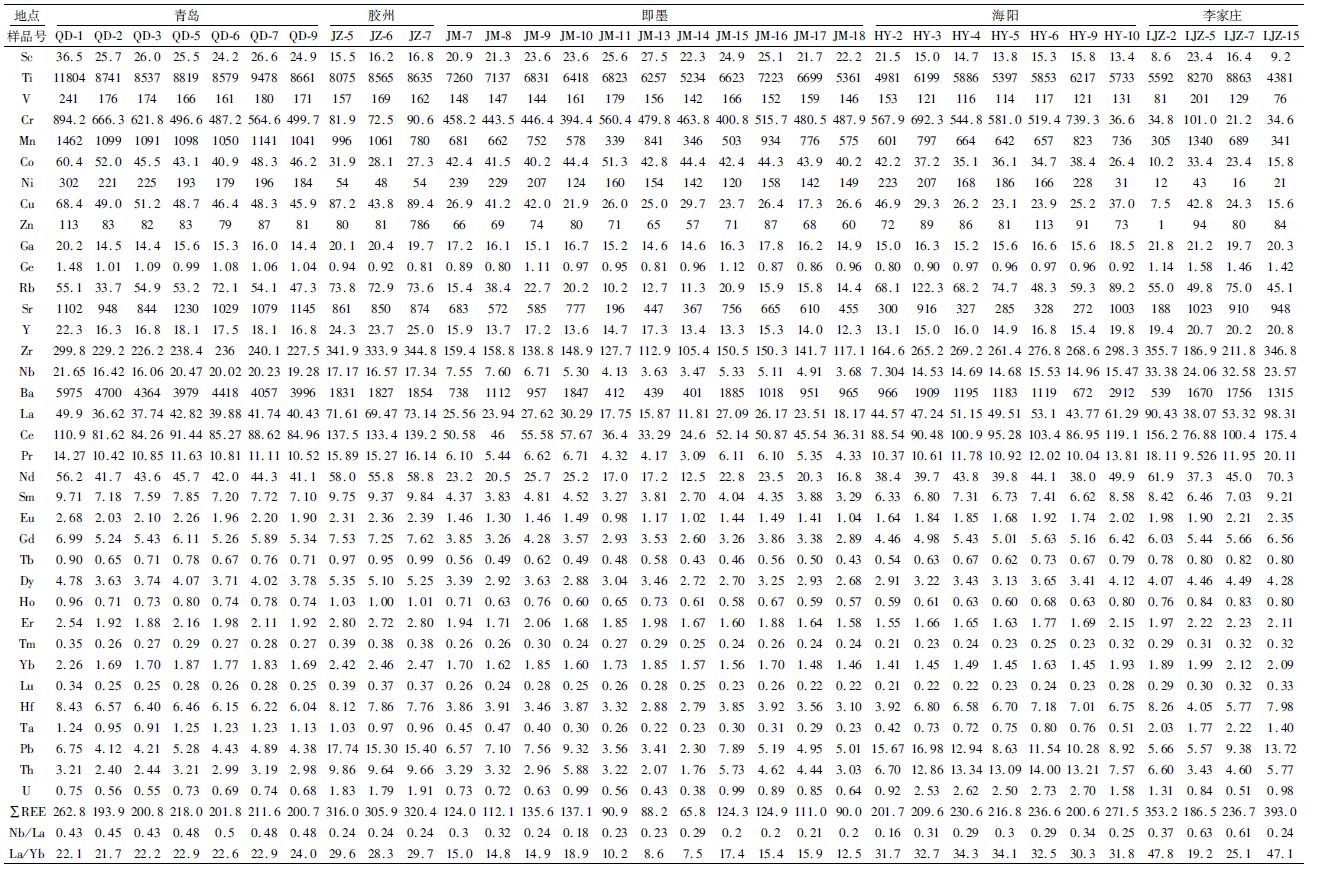2. 中国科学院研究生院, 北京 100049;
3. 广东省有色金属地质勘查局地质勘查研究院, 广州 510080
2. Graduate University of Chinese Academy of Sciences, Beijing 100039, China;
3. Geological Survey Institute, Guangdong Nonferrous Metals Geological Survey Bureau, Guangzhou 510080, China
华北克拉通东部岩石圈从古生代以来发生了约120km的减薄 (Fan and Menzies, 1992; Menzies et al., 1993; Griffin et al., 1998; Menzies and Xu, 1998)。早期古老的巨厚富集岩石圈地幔在古生代以后被薄的亏损型软流圈或大洋型地幔所取代(郑建平, 1999;Xu, 2001; Gao et al., 2002),且从中生代以后进入岩浆、构造变形、成矿、盆地形成等强烈发育的时期(Guo et al., 2001; Zhang et al., 2002; Yang et al., 2003)。尽管目前对华北克拉通破坏发生的时间、机制及其控制因素等还存在激烈的争论(吴福元等,2008;徐义刚等,2009;高山等,2009;朱日祥等,2011),但不同学者都承认晚中生代是华北克拉通岩石圈转型的关键时期。对这一时期岩石圈性质和深部过程的了解是华北克拉通破坏研究中的重要内容。
中生代岩石圈地幔样品(如橄榄岩包体)出露较少,而来源于地幔的中-基性岩浆分布相对较广。基性岩浆是由几十公里或更大尺度的地幔熔融形成,岩浆作用可以减弱由于小尺度地幔所表现出的不均一性,因此基性岩浆相对于厘米~米级尺度的幔源包体更能够体现地幔的整体特征。正因为如此,近年来对华北中生代岩浆作用的研究十分活跃(如Fan et al., 2001, 2004; Guo et al., 2001; Zhang et al., 2002, 2003a; Xu et al., 2004a, b ; Chen and Zhai, 2003; Xu et al., 2006; Gao et al., 2008; Liu et al., 2008; Ling et al., 2009)。这些岩浆活动共同的地球化学特征是:高度富集大离子亲石元素(LILE)和轻稀土元素(LREE),亏损高场强元素(HFSE),富集的Sr-Nd同位素组成,是岩石圈进入拉张期的表现。
目前关于中生代岩浆岩的研究已经积累了大量的资料,但仍存在如下问题:(1) 研究多集中在岩石地球化学和同位素地球化学示踪等方面,而相关的年代学工作相对较少,而且部分定年方法为K-Ar法,存在因K含量测量的不准确性而带来的误差。虽然年代学工作指示华北中生代火山作用集中在早白垩世,但持续时间及长短还不清楚。(2) 岩石成因也有不同的看法。多数学者认为早白垩岩浆来源于富集岩石圈地幔(Fan et al., 2001, 2004; Guo et al., 2001; Xu, 2001; Zhang et al., 2002, 2003a; 刘燊等, 2003;邱检生等,2004; Xu et al., 2004a, b ;Yang and Li, 2008),部分学者则认为是拆沉下地壳来源的熔体与上地幔反应的产物(Gao et al., 2008; Liu et al., 2008; Ling et al., 2009)。
本文选择华北中生代火山岩主喷发期中最具代表性的青山群火山岩为研究对象,采用比K-Ar 法更优越的Ar-Ar 法对胶东青山群火山岩进行定年,以期确定青山群火山岩的形成时代;根据地球化学和Sr-Nd-Pb同位素组成,对青山群基性岩的岩石成因进行约束,最后综合年龄和地球化学资料,探讨华北克拉通破坏过程。
2 区域地质背景、样品和分析方法本文研究的青山群火山岩主要产于胶莱盆地。胶莱盆地是一个白垩纪断陷拉分盆地,其西侧以郯庐断裂带为界,盆地东南部是属于苏鲁造山带的胶南隆起带,西北部为胶北隆起所限(图 1)。该盆地经历了多阶段构造演化历史,通常认为郯庐断裂和牟平-即墨断裂是胶莱盆地的控盆断裂,这两条断裂的右旋拉分控制了胶莱盆地的形成和发展(戴俊生和陆克政,1995;Zhu et al., 2012)。盆地充填序列和构造样式分析(Zhang et al., 2003b)进一步表明,胶莱盆地的形成经历了3个盆地构造伸展阶段:早白垩世莱阳期、早白垩世青山期至大盛期和晚白垩世王氏期,三个构造伸展阶段为三次构造挤压反转事件所隔。
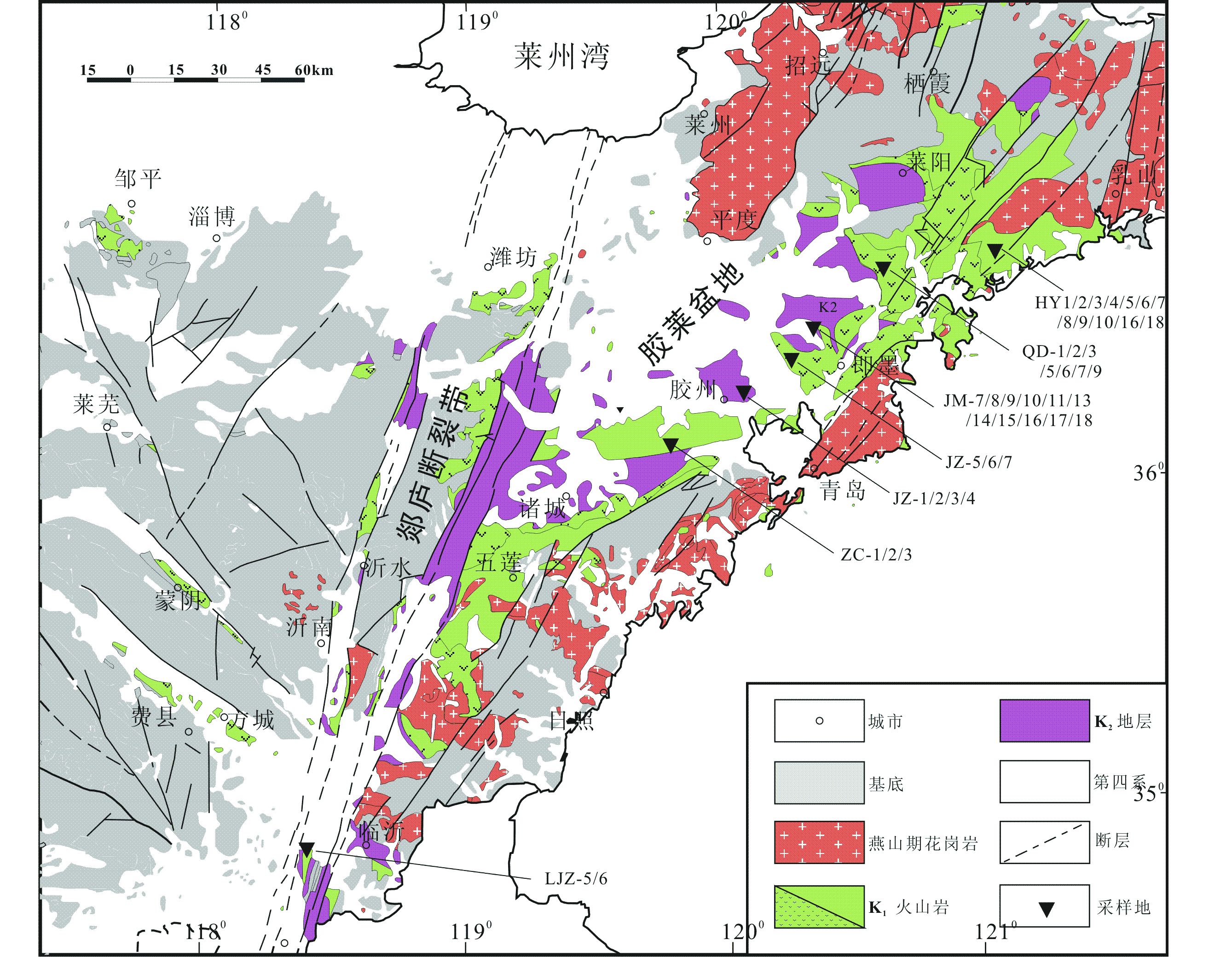
|
图 1 山东省地质简图和青山群火山岩采样位置 样品号前缀: QD-青岛保驾山;JM-即墨姜家庄-大信村;HY-海阳县城北;JZ-胶州市东;LJZ-郯城李家庄 Fig. 1 A simplified geological map of Shandong Province and sample location of Qingshan Group volcanic rocks |
早白垩世火山作用主要出现在青山期。胶东青山群地层由凝灰质砂岩、安山岩、流纹岩、凝灰岩、集块岩、砂砺岩、火山碎屑岩夹红色泥岩组成。青山群火山作用自下而上分为四期,即后夼组、八亩地组、石前庄组和方戈庄组。其中后夼组和石前庄组主要为长英质岩石,而百亩地和方戈庄组主要为安山岩和玄武岩。前人发现郯庐断裂两侧,即鲁西和胶东地区的青山群的组成有较大的差别,鲁西主要发育基性岩,年龄在128~115Ma,而胶东为双峰式火山岩,喷发时代在106~98Ma(邱检生等,2001;凌文黎等,2006)。因此,胶东青山群火山作用晚于鲁西地区青山群火山活动。
关于胶东青山群火山岩研究,前人主要集中的中酸性岩浆(Ling et al., 2009; 邱检生等, 2004; 闫峻和陈江峰, 2007)。鉴于讨论深部岩石圈地幔性质的目的,本文重点考察了基性岩浆。样品分别采自青岛保驾山(QD),即墨县城北姜家庄-大信村一带(JM),海阳县城北(HY),胶州市东(JZ);郯城李家庄(LJZ)(图 1)。大多数样品呈灰色-灰黑色,斑状-显微斑状结构,局部发育气孔构造,玄武岩斑晶以长石辉石为主。各地样品岩相学特征描述如下(图 2)。
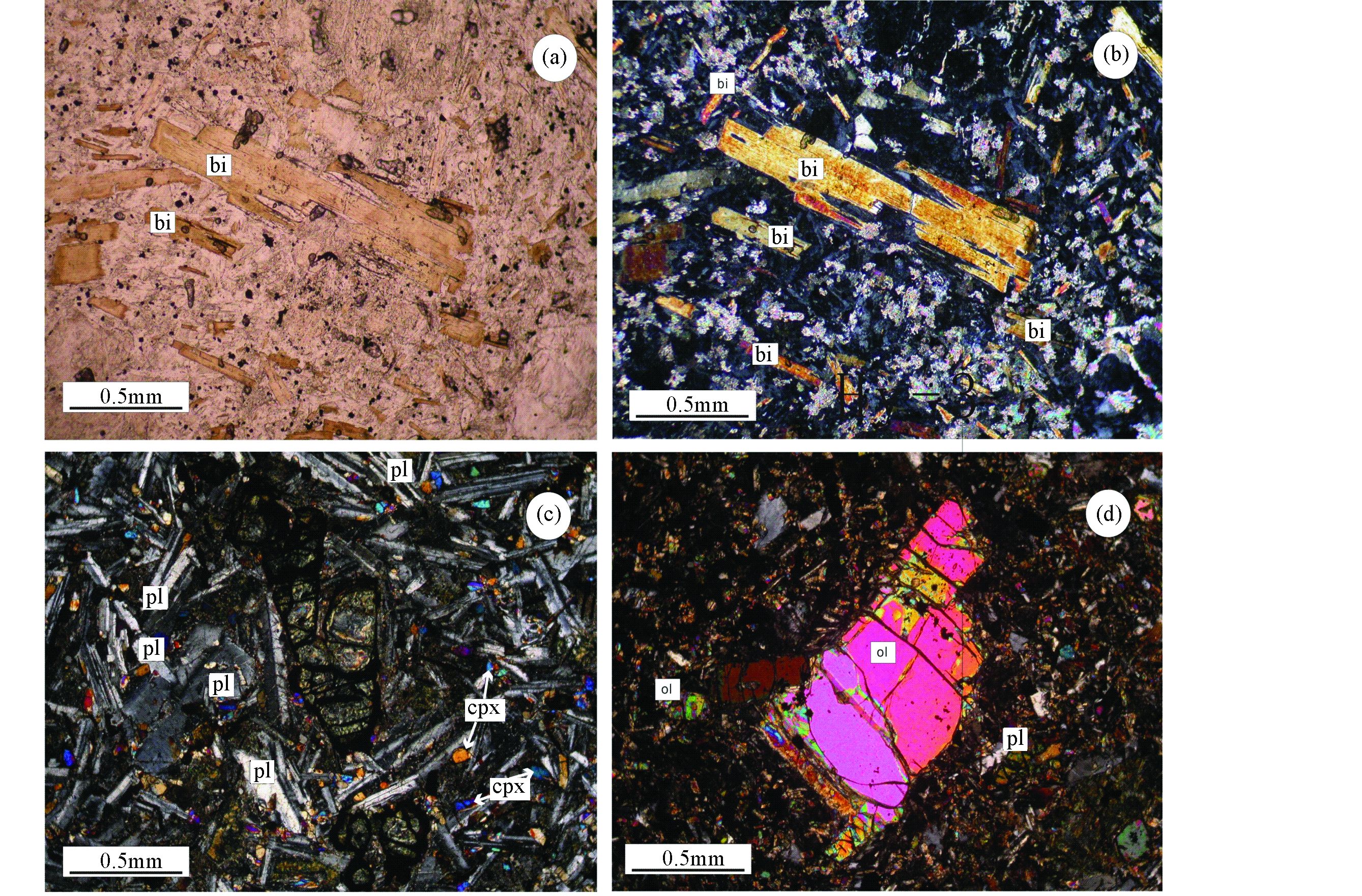
|
图 2 胶东青山群基性火山岩的岩相学特征 Fig. 2 Petrographic characteristics of the mafic rocks of the Qingshan Group in Jiaodong Peninsula |
青岛橄榄玄武岩(QD):灰色,致密块状,隐晶质结构,发育少量气孔及杏仁体(硅质充填)。斑晶主要为橄榄石,约5%,多为半自形-自形,偶见呈骨架状橄榄石斑晶,沿裂隙或边部有时发生伊丁石化;单斜辉石斑晶粒径较橄榄石大些(1~8mm),自形或半自形,常见呈弱的粉红色,有时可见双晶或环带,聚晶结构亦有时可见,表面时有氧化物分布。基质呈间粒-间隠结构,主要由细小的板条状斜长石(30%~40%)、单斜辉石(30%~40%)及少量橄榄石、钛铁氧化物组成。
即墨玄武(安山)岩(JM):呈黑灰色,斑状结构,基质微细粒结构,块状构造。斑晶为长石,含量<2%;基质间粒结构,斜长石70%~80%,辉石约20%~30% 。
海阳(玄武)安山岩(HY):呈斑状结构,基质呈隐晶质结构,块状构造,斑晶主要为长石,个别样品见少量黑云母斑晶,斑晶被溶蚀 。
胶州(JZ)玄武安山岩:呈斑状结构,基质呈隐晶质结构,块状构造,斑晶为辉石,基质呈隐晶质结构。
郯城李家庄(LJZ)玄武岩、安山岩:玄武岩呈斑状结构,基质呈隐晶质结构,块状构造,斑晶为少量辉石、橄榄石;安山岩呈灰色-灰褐色,斑状结构,斑晶为长石,少量辉石,基质呈隐晶质结构。
3 分析方法主量、微量元素和Sr-Nd同位素分析均在中国科学院广州地球化学研究所同位素地球化学国家重点实验室完成。主量元素在Rigaku ZSX100e仪器上完成,微量元素测定在PE Elan 6000型电感耦合等离子体质谱仪(ICP-MS)上完成,分析方法见刘颖等(1996) 。微量元素分析精度通常优于5%。用于Sr-Nd同位素分析的样品先进行了稀盐酸的淋漓,然后在Teflon溶样器皿中用HF+HNO3酸溶解,并用传统的阳离子交换柱方法分离。同位素分析在Micromass IsoprobeTM型多接收电感耦合等离子体质谱(MC-ICPMS)上完成,详细的分析方法见韦刚健等(2002) 和梁细荣等(2003) 。测得的87Sr/86Sr和143Nd/144Nd比值分别用86Sr/88Sr=0.1194和146Nd/144Nd=0.7219标准化。40Ar/39Ar定年通过全岩激光阶段加热在GV5400稀有气体质谱计上测定,标样为ZBH-2506黑云母(132Ma),分析步骤和J值计算方法见Qiu and Jiang (2007) 。
4 分析结果 4.1 Ar-Ar年代学选择五个产地(青岛、即墨、海阳、胶州、郯城)青山群火山岩中6个代表性样品进行了了40Ar/39Ar定年。40Ar/39Ar法的优点在于只需测定活化样品的Ar同位素比值即可计算样品的年龄,避免了K含量的不准确性带来的误差。通过多阶段激光加热所获数据结果列于表 1。即墨两个玄武岩样品(JM-7, JM-15)具有非常相似的Ar-Ar坪年龄(122.0Ma,图 3)。样品JM-7的等时线年龄为120.52±3.32Ma,在误差范围内与坪年龄一致;样品JM-15的等时线年龄为117.09± 2.62Ma,略低于坪年龄。胶州玄武安山岩(JZ-6)的Ar-Ar坪年龄和等时线年龄分别为119.3±0.5Ma和119.2±0.78Ma。海阳玄武安山岩(HY-2)的Ar-Ar坪年龄为113.0±1.3Ma,略小于等时线年龄114.5±5.4Ma。李家庄玄武岩安山岩的Ar-Ar坪年龄最为年轻(99.7±0.4Ma),与等时线年龄(99.38±0.59 Ma)完全一致。由上可知,本次分析的6件样品的Ar-Ar坪年龄与等时线年龄基本一致(图 3),除JM-15外其余样品的(40Ar/ 36Ar)i 值在270~304之间,接近大气值,说明过剩氩并不明显。因此,本文获得的坪年龄可以代表青山群基性火山的真实喷发年龄。
|
|
表 1 山东青山群火山岩全岩 Ar-Ar分析数据 Table 1 Whole rock Ar-Ar analytical results of the volcanic rocks of Qingshan Group from Shandong |
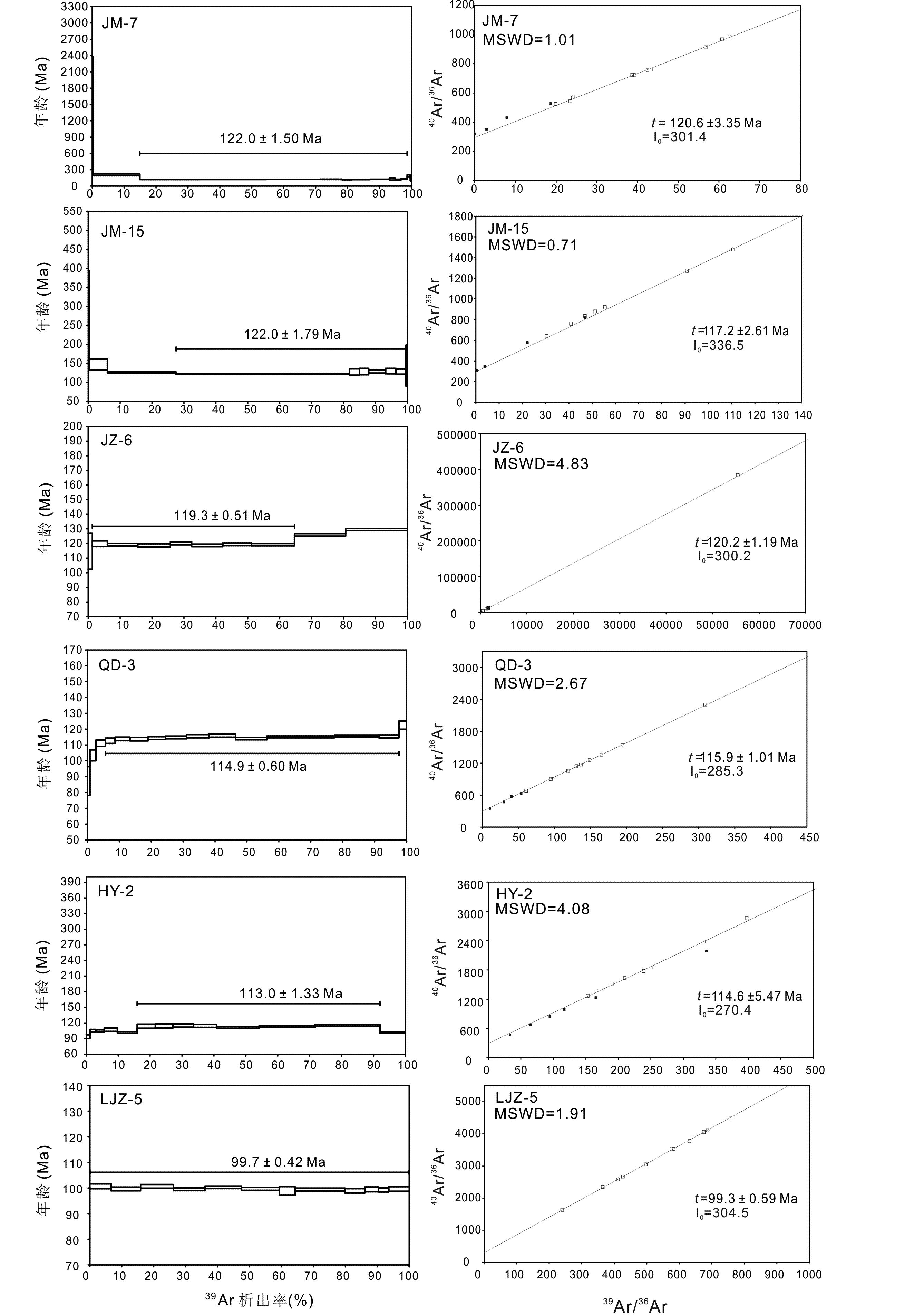
|
图 3 胶东青山群基性火山岩的40Ar-39Ar 坪年龄谱和40Ar/36Ar-39Ar/36Ar等时线图等时线年龄图中实心方形数据不参与等时线年龄计算 Fig. 3 Ar-Ar age spectra and 40Ar/36Ar versus 39Ar/36Ar correlation of the Qingshan Group mafic rocks in Jiaodong Peninsula |
主量元素数据和CIPW标准矿物计算结果见表 2。所研究样品的烧失量(LOI)在0.92%~10%之间,尤其是即墨和海阳样品的烧失量较高,说明这些样品经历了较大程度的蚀变作用,而其他地区样品的烧失量在2%~3%。LOI与SiO2和K2O形成较为明显的负相关关系,说明在蚀变过程中样品的SiO2和K2O含量有所降低,而其他元素与LOI没有形成相关关系。为了能够系统对比各地青山群火山岩,减少蚀变的影响,将LOI扣除后将元素含量重新计算并归一至100%。
|
|
表 2 胶东青山群火山岩主量元素(wt%)和CIPW标准矿物 Table 2 Major element composition (wt%) and CIPW modes of the volcanic rocks of the Qingshan Group from Jiaodong Peninsula |
胶东青山群基性火山岩的主量元素成分变化较大,其中SiO2含量在50%~60%之间,MgO含量在1%~10%,其中青岛橄榄玄武岩的MgO含量最高(8.79%~9.75%),而李家庄样品的MgO含量最低(1%~6%)。由于SiO2和K2O的含量可能受到蚀变作用的影响,因此传统的TAS图解不适合用于样品分类。因此,本文采用Zr/TiO2-Nb/Y分类方案(Winchester and Floyd, 1976)。从图 4a可以得出,青岛橄榄玄武岩落入碱性玄武岩和粗玄岩区,而且其CIPW标准矿物组成不出现Q,而出现Ne,因此属于碱性系列。而即墨和海阳样品为玄武安山岩或安山岩,都有Q、Hy出现,属于亚碱性岩石系列。在ALK-MgO-FeOT图上这些样品都落入了钙碱性系列区域(图 4b),确定其为钙碱性系列的岩石。李家庄样品较为特殊,属于粗面玄武岩-安山岩-安粗岩。
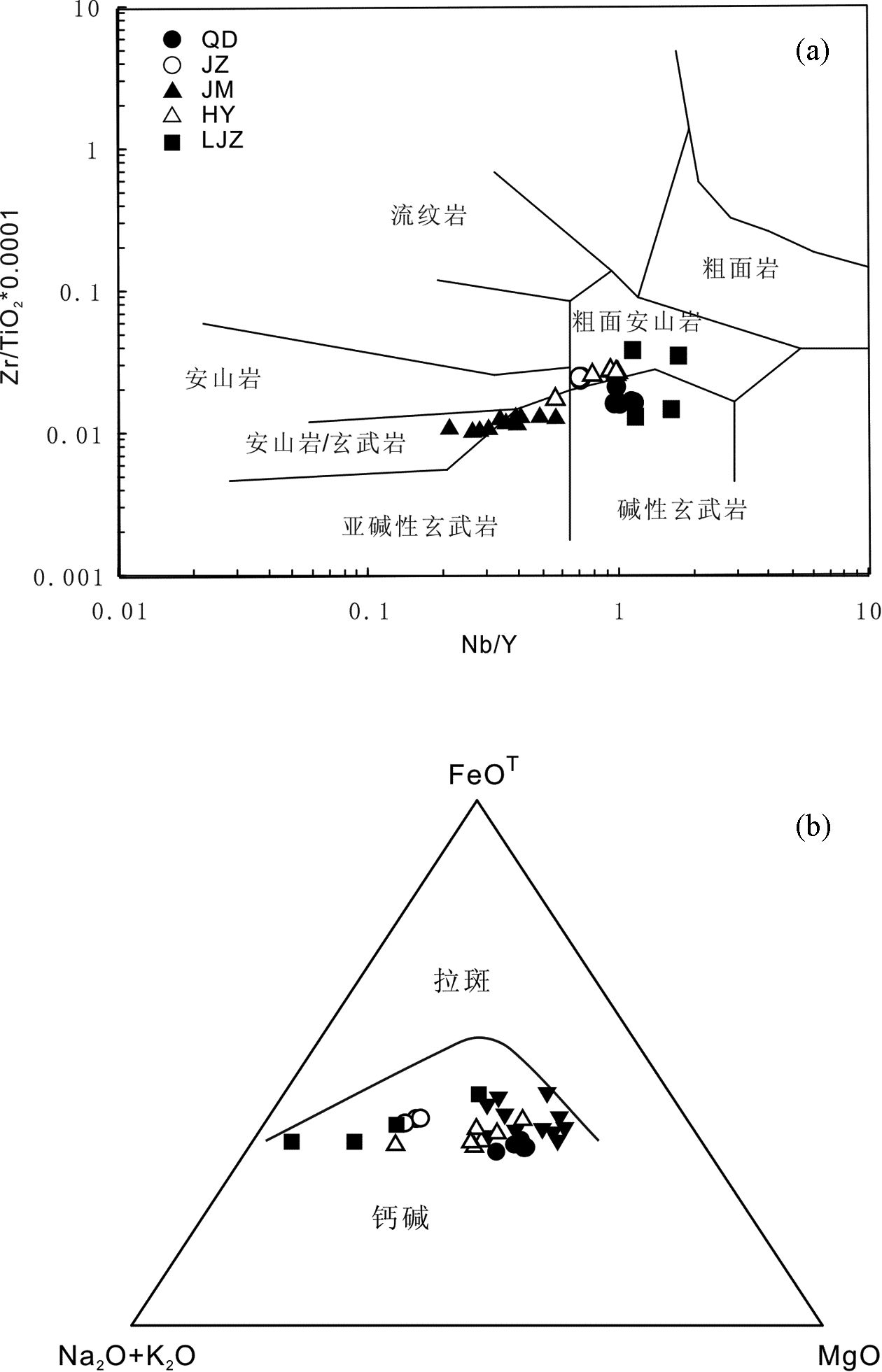
|
图 4 胶东青山群基性火山岩的Zr/TiO2-Nb/Y图解(a, 据Winchester and Floyd, 1976)和ALK-MgO-FeOT图解(b) Fig. 4 Plots of Zr/TiO2-Nb/Y (a, after Winchester and Floyd, 1976) and ALK-MgO-FeOT (b) for the Qingshan Group mafic rocks in Jiaodong Peninsula |
图 5展示了胶东青山群火山岩中SiO2,Al2O3,CaO, TiO2,Fe2O3和Na2O与MgO的相关关系。李家庄样品显示了较好的相关性,如SiO2,Al2O3和Na2O与MgO之间的负相关关系,CaO, TiO2,Fe2O3与MgO之间的正相关关系(图 5)。在其余样品中,也见有SiO2与MgO之间的负相关关系以及Fe2O3与MgO之间的正相关关系,但未见其他元素的相关性,这可能暗示各地岩浆源区的不均一性。例如,MgO-TiO2图解显示,在相同的MgO含量,海阳、即墨、胶州+青岛样品中的TiO2含量分别为1%,1.1%~1.2%和1.4%,说明Ti含量的差异是源区特征。
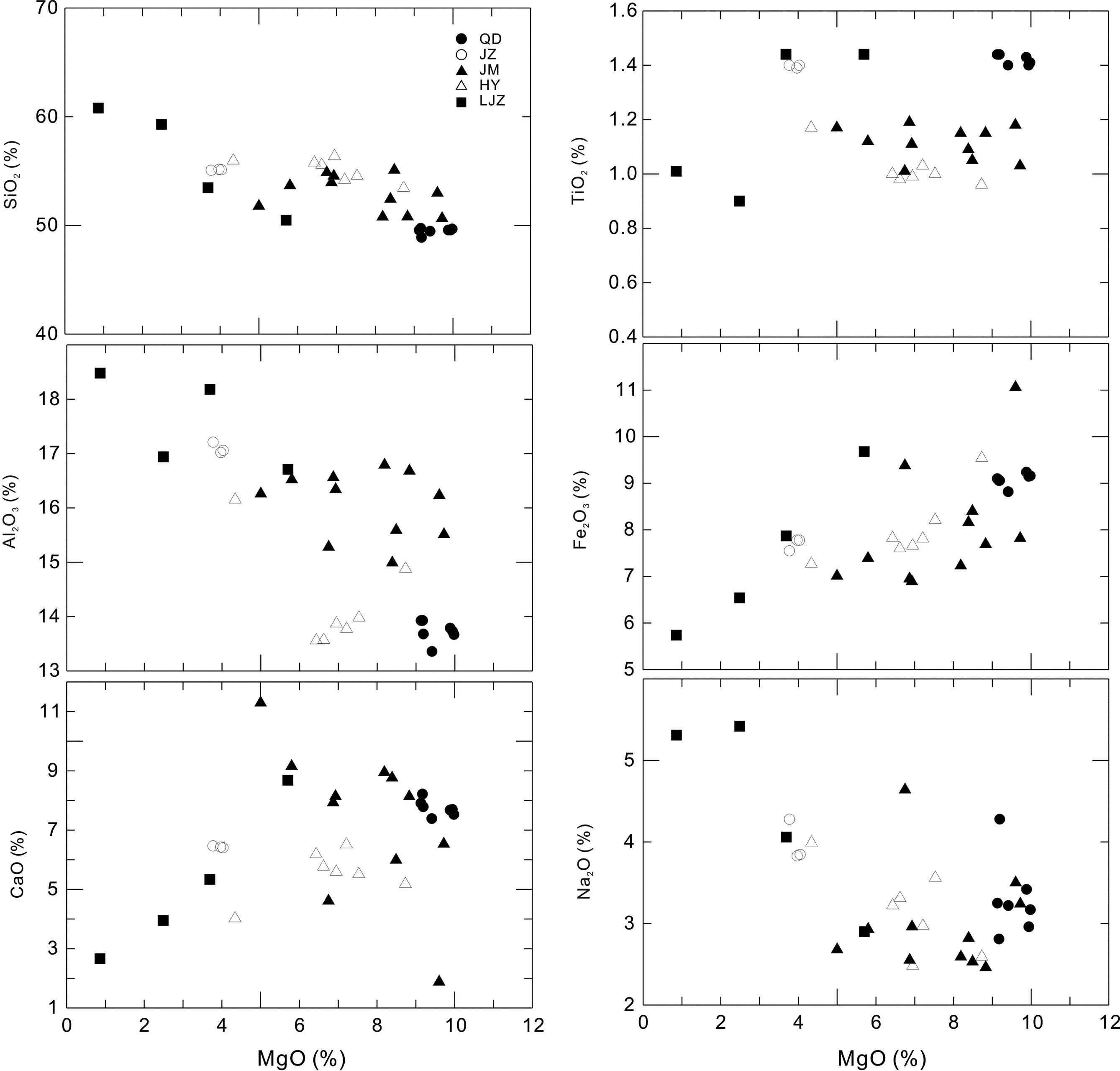
|
图 5 胶东青山群基性火山岩主量元素与MgO相关图 Fig. 5 Plots of major oxides against MgO for Qingshan Group mafic rocks in Jiaodong Peninsula |
胶东青山群火山岩的稀土含量也显示较大的范围(表 3),其中即墨样品的REE总量较低(66×10-6~137×10-6),而胶州样品REE较高(305×10-6~320×10-6),李家庄安粗岩中REE含量最高(393×10-6)。在球粒陨石标准化的稀土分配图上 (图 6),所有样品都表现出轻稀土富集的平滑分布模式[(La/Yb)CN=5.39~34.26],重稀土弱分异[(Gd/Yb)CN=1.65~3.64],铕异常不明显。李家庄和胶州样品具有较低的相容元素含量,Ni(11.8×10-6~54.2×10-6)、Co(10.2×10-6~33.4×10-6)、Cr(21.2×10-6~101×10-6)、Sc(8.2×10-6~23.4×10-6)。
|
|
表 3 胶东青山群火山岩微量元素含量(×10-6) Table 3 Trace element composition of the volcanic rocks of the Qingshan Group from Jiaodong Peninsula(×10-6) |
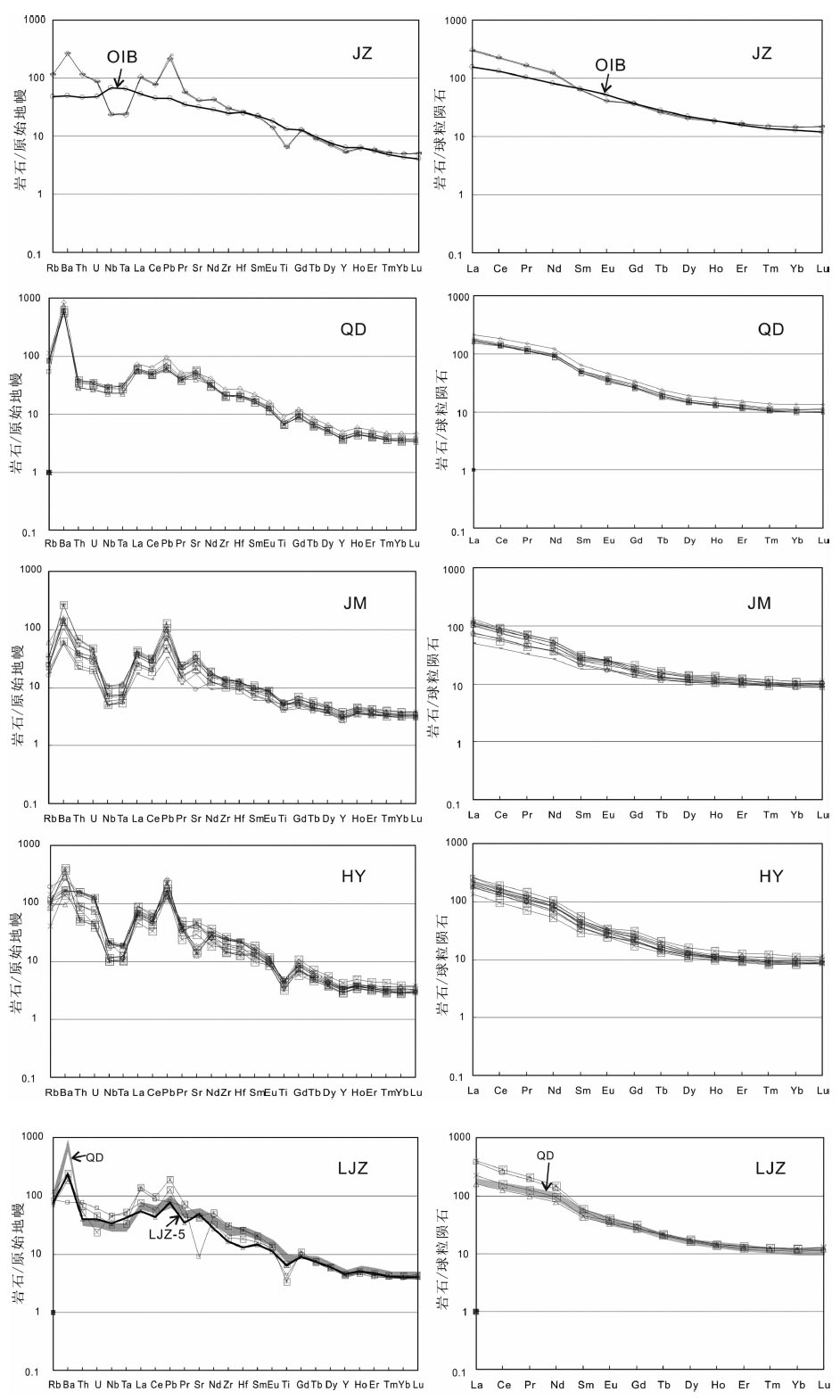
|
图 6 胶东青山群基性火山岩微量元素蛛网图与稀土元素标准化图(原始地幔和球粒陨石值据Sun and McDonough, 1989) Fig. 6 Normalized REE pattern and spiderdigram of the Qingshan Group mafic rocks in Jiaodong Peninsula (normalization values after Sun and McDonough, 1989) |
胶东青山群火山岩的原始地幔标准化的微量元素蛛网图较为相似(图 6),均表现出强烈富集LREE、Ba、Pb,亏损Nb, Ta和Ti,明显不同于洋岛玄武岩(OIB)玄武岩(Sun and McDonough, 1989)。青岛和李家庄样品还表现出Th-U的相对亏损(图 6)。
4.2.3 Sr-Nd同位素与中国东部新生代玄武岩(87Sr/86Sr(t)<0.7050,εNd(t)=0~7)相比,胶东青山群火山岩具有高87Sr/86Sr(t)(0.7058~0.7095)和低εNd(t)(-16.8~-7.8)的同位素特征(表 4;图 7),与文献中报道的华北中生代样品的同位素组成相似(图 7)。海阳样品的87Sr/86Sr(t)比值最高,变化于0.7079~0.7095之间,εNd(t)最低(-16.8)。在87Sr/86Sr(t)-εNd(t)图解上,一部分海阳(玄武)安山岩落在大别造山带同碰撞铁镁-超铁镁质岩的范围(李曙光等, 1998, Jahn et al., 1999)。李家庄样品的87Sr/86Sr(t)比值最低且变化不大 (0.7058~0.7063),但其εNd(t)变化很大 (-7.8~-16.4),其中样品LJZ-5的εNd(t)最高(-7.8)(图 7)。其余样品的 Sr-Nd同位素比值则介于LJZ-5和海阳样品之间。
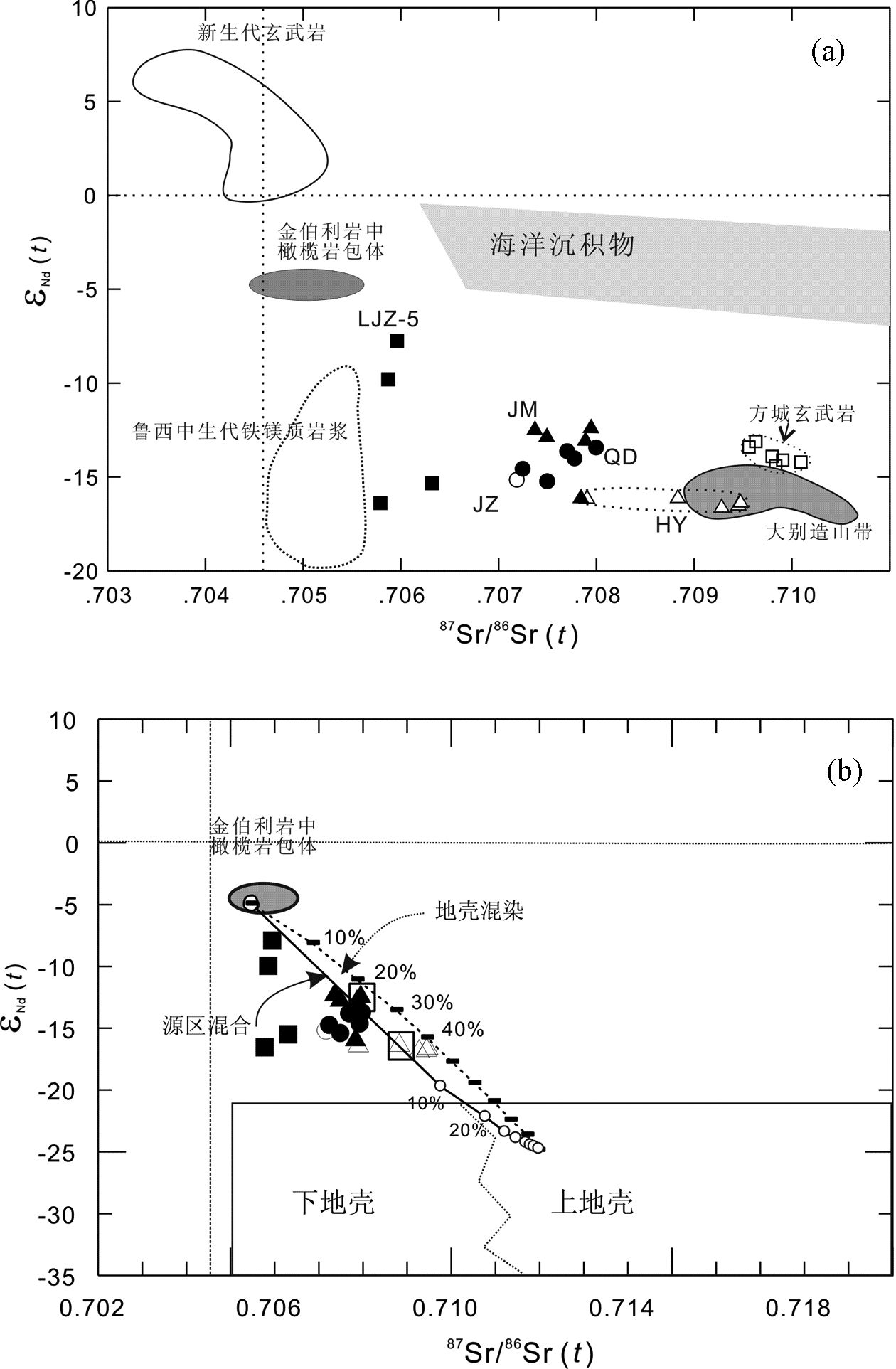
|
图 7 胶东青山群基性火山岩εNd(t)-(87Sr/86Sr)t图解(a)和源区混合和地壳混染对岩浆同位素组成的影响示意图(b) (a)中数据来源: 鲁西中生代铁镁质岩浆据Guo et al.(2001, 2003);新生代玄武岩的范围据Peng et al. (1986) , Basu et al. (1991) , Song et al. (1990) , Xu et al. (2005) , Tang et al. (2006) , Xu et al. (2012) ;大别造山带的范围据李曙光等(1998) 和Jahn et al. (1999) ;海洋沉积物出自Ben Othman et al. (1989) 和McLennan et al. (1990) ;金伯利岩所含包体据郑建平和路凤香(1999) .(b)中模拟计算参数见表 5 Fig. 7 Sr-Nd isotopic composition of the Qingshan Group mafic rocks in Jiaodong Peninsula (a) and diagram showing mixing models for source (solid line) and melt contamination (dotted line) (b) |
|
|
表 4 胶东青山群火山岩Sr-Nd同位素组成 Table 4 Sr-Nd isotopic composition of the volcanic rocks of the Qingshan Group from Jiaodong Peninsula |
|
|
表 5 模拟计算参数 Table 5 The parameters used in simulation calculation |
青山群火山岩在鲁西、沂沭断裂带以及胶东地区均有分布。前人对青山群火山岩进行了较为系统的同位素定年。对蒙阴地区八亩地组和方戈庄组火山岩定年表明,鲁西青山群的年龄在128~115Ma之间(邱检生等,2001a;Ling et al., 2009)。邱检生等(2001b)运用40Ar - 39Ar 定年技术对胶莱盆地五莲分岭山青山群火山岩中两个旋回的样品进行了年龄测定,获得了109.9±0.6Ma和108.2±0.6Ma。凌文黎等(2006) 报道了胶州盆地青山群分组定名剖面底部和顶部的锆石U-Pb年龄分别为106±2Ma和98±1Ma。这些资料显示山东省境内青山群火山岩系形成时代在空间上具有由西向东明显变轻的趋势;胶东地区的青山群火山岩形成年龄(110~98Ma)要晚于鲁西地区(128~115Ma)(邱检生等, 2001b; 凌文黎等, 2006)。
前人研究的胶东青山群火山岩都属中偏酸性火山岩,而本文重点考察了基性岩石(除李家庄外)。Ar-Ar定年结果显示胶东青山群基性火山岩的年龄在122~100Ma。 需要指出的是最年轻的年龄(99.7Ma)是在位于沂沭断裂带内李家庄粗面玄武岩中测得的,而真正位于胶莱盆地的其余5个样品的年龄在122~113Ma之间。由此我们认为,东地区青山群火山岩为双峰式(Ling et al., 2009),但两者并不同时形成,基性岩(122~113Ma)的形成早于酸性岩(110~98Ma)(图 8)。这连同酸性岩中REE含量低于基性岩的事实(Ling et al., 2009),说明两者之间不存在结晶分异关系。
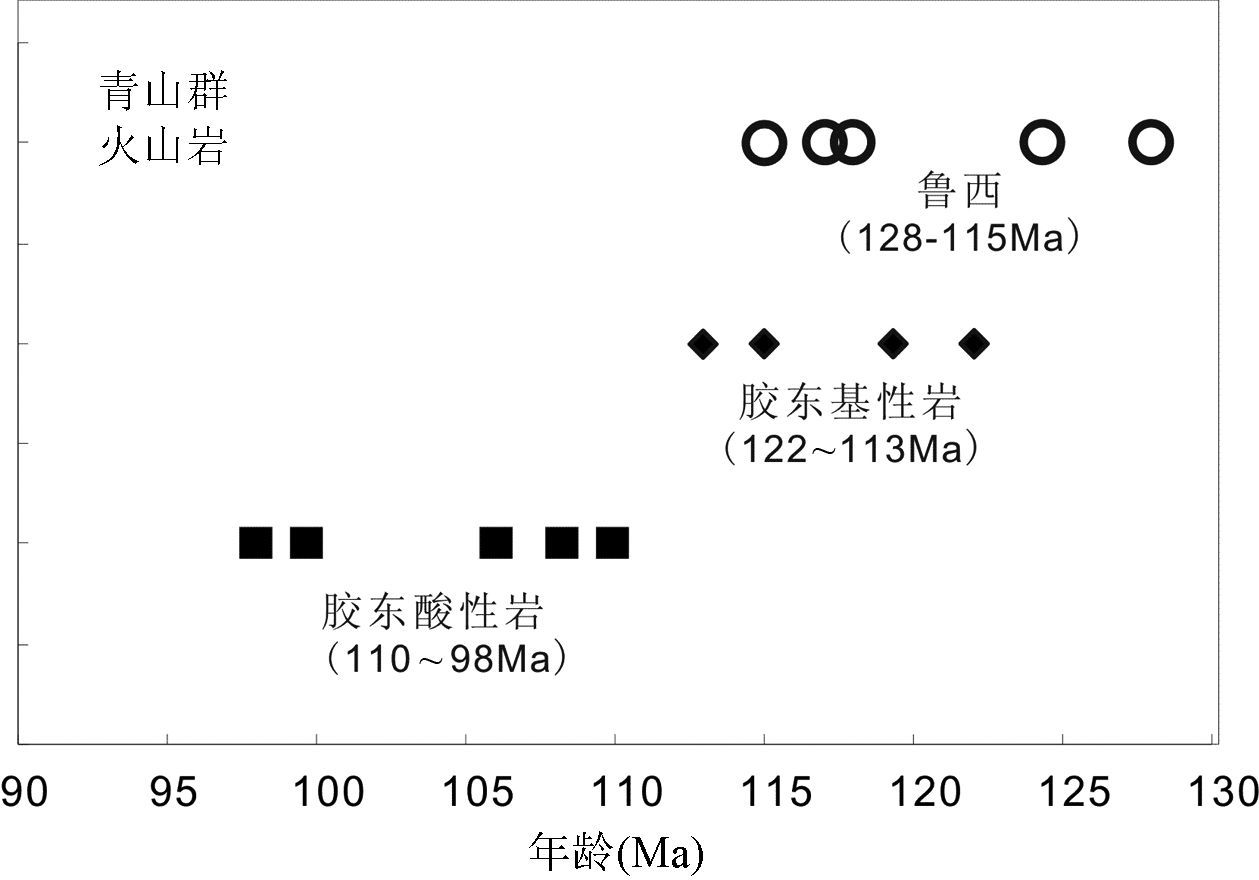
|
图 8 鲁西和胶东青山群火山岩喷发时代对比(数据据邱检生等, 2001a, b ; 凌文黎等, 2006; Ling et al., 2009;本文) Fig. 8 Comparison of eruption age of the Qingshan Group volcanic rocks from western Shandong and Jiaodong Peninsula (Data after Qiu et al., 2001a, b ; Ling et al., 2006, 2009; this study) |
新的年龄资料也使山东境内青山群火山岩的时空分布特征更为复杂。例如位于沂沭断裂带附近的李家庄样品的年龄最为年轻(99.7Ma),而位于其东侧的即墨玄武岩的年龄为122Ma。这与原先认为的青山群火山岩由西向东变年轻的趋势不符。尽管如此,鲁西和鲁东地区岩浆作用的时空差异依然存在(图 8)。鲁西青山群火山岩喷发较早,且持续较短(128~115Ma),而胶东地区青山群火山岩略晚出现(122Ma),且持续时间较长(122~98Ma)。考虑到覆盖在青山群之上的王氏组(76~72Ma)也只出现在胶东地区,因此郯庐断裂以东地区的岩浆活动较鲁西地区更为强烈。
新的年龄资料进一步支持关于胶东和鲁西地区中生代地质作用的重大差异的认识(徐贵忠等,2002)。这种区域性差异值得做深入的研究,但可能与以下因素有关:(1) 郯庐断裂带的大规模左旋平移运动导致了胶东地区岩石圈大规模伸展以及胶莱盆地的形成(Zhu et al., 2012);(2) 胶东较鲁西地区更靠近库拉-太平洋板块的消减带, 处于壳幔相互作用更为强烈的构造环境(徐贵忠等,2002); (3) 胶东较鲁西地区更靠近苏鲁超高压带,因此陆壳深俯冲加剧这一地区深部岩石圈与再循环地壳物质相互作用(Xu et al., 2004b),有利于岩浆作用的发生。
5.2 岩石成因 5.2.1 地壳混染和结晶分异作用山东青山群火山岩MgO和Cr, Ni, Nb-Ta含量变化范围较大,暗示岩浆分异作用或地壳混染作用。因此在制约岩浆熔融源区前有必要讨论岩浆在上升到地表过程中是否经历了地壳混染作用或结晶分异作用。所有样品表现出强烈的Nb-Ta亏损,部分样品较高的Th含量和富集的Sr-Nd同位素组成特征暗示在岩石形成过程中可能有地壳物质的加入。在Nb/La-SiO2和εNd(t)-SiO2图解上(图 9),李家庄样品显示了负相关关系,而在εNd(t)-MgO图上形成正相关关系(图 9),这与地壳混染模型的预测(DePaolo, 1981)相一致。在主量元素与MgO相关图上,李家庄样品形成了较好的线性关系,其中Na2O、K2O、SiO2、Al2O3与MgO呈负相关,Fe2O3、CaO与MgO呈正相关(图 4),显示了两端元混合的特征。李家庄粗安岩的MgO和Cr,Ni含量相对低于李家庄玄武安山岩,因此推测李家庄安粗岩岩浆是李家庄粗面玄武岩岩浆经地壳混染后的产物。其中LJZ-5样品具有相对低的SiO2含量(49.2%),且具有最高的εNd(t)值(-7.8),所以该样品代表了受地壳混染程度最小的晚中生代幔源岩浆。
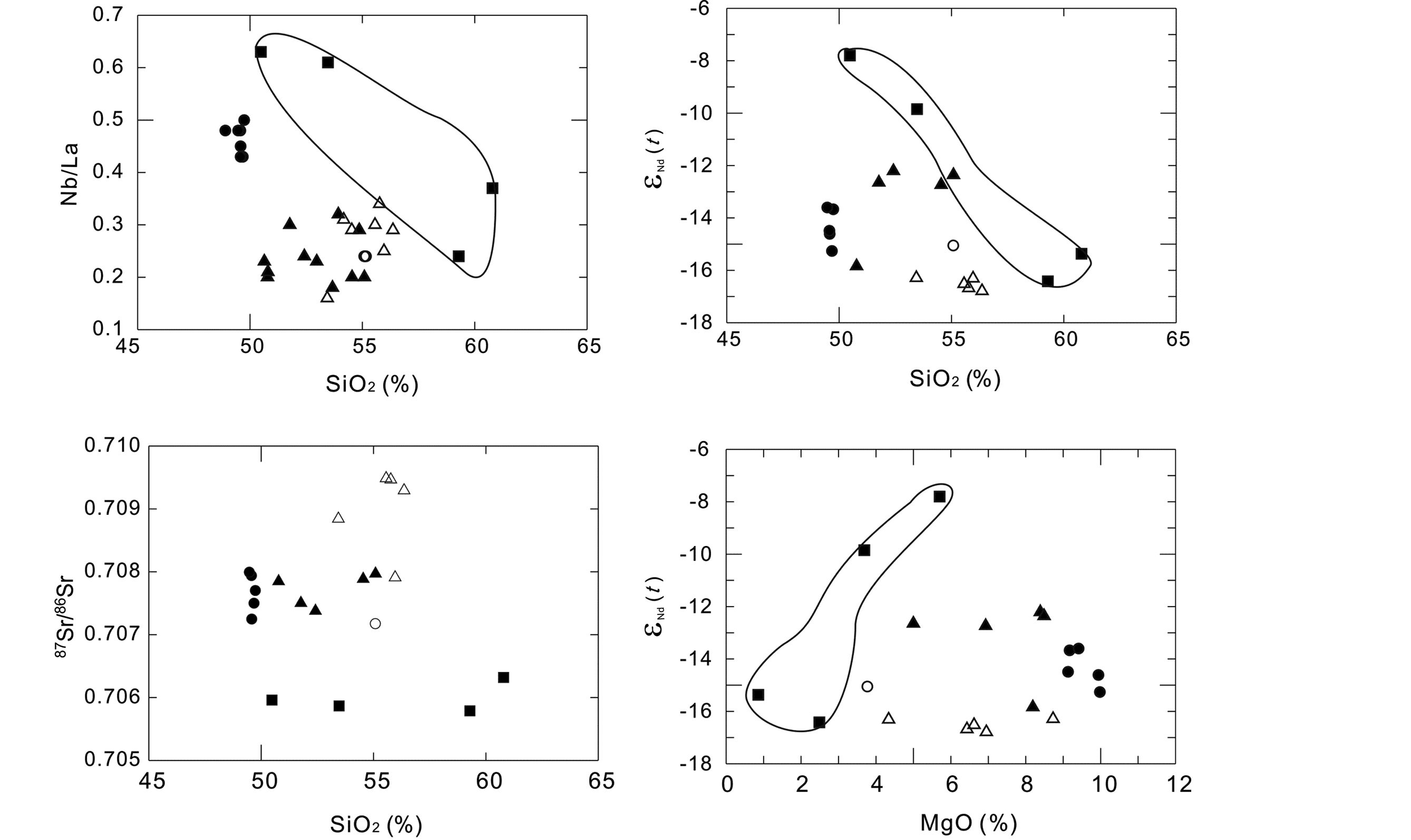
|
图 9 Nb/La、εNd(t)、87Sr/ 86Sr(t)对SiO2图解(a-c)和εNd(t)对MgO图解(d) Fig. 9 Plots of Nb/La, εNd(t), 87Sr/ 86Sr(t) vs. SiO2 (a-c) and εNd(t) vs. MgO (d) |
在判断地壳混染的二元相关图解(图 9)上,其余各地青山群基性岩浆的87Sr/86Sr(t)和εNd(t)比值与SiO2的变化关系不明显 (图 5),说明受到结晶混染作用(AFC过程)的影响不大(DePaolo, 1981)。简单的模拟计算表明,如果这些基性火山岩样品的高87Sr/86Sr(t)和低εNd(t)值是来自与LJZ-5同位素成分接近的岩石圈地幔的基性岩浆受地壳混染影响的结果,那么地壳混染比例为30%~40%(图 7b)。如此高的地壳比例显然难以保留青山群火山岩的基性岩的性质。因此,除李家庄样品,其余的青山群火山岩的元素和同位素组成受地壳混染的影响很小,反映了岩浆源区的性质。
主量元素之间的相关关系(图 5)说明橄榄石和辉石为主要的分离结晶矿物。青山群基性岩浆缺乏Eu的负异常,因此长石不是主要的分离结晶矿物。FeO-MgO之间的负相关关系以及Ti的负异常暗示指示钛铁氧化物的晶出, 但TiO2与MgO不存在相关关系,因此Ti的负异常更可能反映了源区的特征。
5.2.2 岩浆源区特征青山群火山岩富集大离子亲石元素和轻稀土元素,亏损Nb、Ta、Ti等元素,具有较低的Nb/La比值,以及富集的 Sr-Nd同位素组成。这些特征完全不同于OIB和中国东部新生代玄武岩(图 6、图 7),因此,它们不可能直接来自软流圈地幔的部分熔融。前面的讨论排除了地壳混染的可能性,因此青山群火山岩显示的地壳指纹可能与岩浆源区存在地壳物质或富集岩石圈地幔组分有关。
如前所述,样品LJZ-5受地壳混染的程度最低,因此其Sr-Nd同位素组成很可能代表了岩石圈地幔源区的组成。值得注意的是,该样品的87Sr/86Sr(t)(0.7060)和εNd(t)(-7.8) 非常接近蒙阴金伯利岩中橄榄岩包体的Sr-Nd同位素组成(87Sr/86Sr(t)=0.705、εNd(t)=-5;郑建平和路凤香, 1999)。这说明李家庄玄武岩可能源自于奥陶纪金伯利岩中橄榄岩包体所代表的地幔源区。与LJZ-5相比,其余地区的青山群火山岩显示了更为富集Sr-Nd同位素组成,在图 7a中落在在大洋玄武岩和大洋沉积物范围之外。因此导致青山群火山岩源区富集的另一(或多个)端员应是大陆地壳,可能与深俯冲扬子板块的陆壳组分有关。
为了验证这一成因模型,我们进行了简单的两端员混合计算。选择蒙阴奥陶纪金伯利岩中橄榄岩包体(郑建平和路凤香, 1999)作为岩石圈地幔端员的成分,混合端员为大陆上地壳(Taylor and McLennan, 1985)。具体的参数见图 7b图例说明。结果表明,在岩石圈地幔源区中加入少量上地壳组分就可以解释在青山群火山岩中所观察到的同位素组成(图 7b)。由混合源区熔融产生岩浆的主量元素组成由地幔组分所控制,而其微量元素和同位素组成则由地壳组分所控制。李家庄样品的同位素组成则暗示其可能遭受了下地壳组分的混染(图 7b)。
5.3 对华北岩石圈减薄作用的启示本文报道的胶东地区青山群基性火山岩形成于122~100Ma,早于青山群酸性火山岩(110~98Ma),而且两类岩石在元素和同位素组成上存在较大的差异(Ling et al., 2009),例如,前者的REE含量高于后者,说明酸性火山岩不是基性岩结晶分异的产物。青山群酸性火山岩的 87Sr/86Sr(t)比值为0.7033~0.7095,εNd(t)为-14.1~-24.0,其Sr-Nd同位素变化范围要大于基性火山岩(87Sr/86Sr(t)=0.7058~0.7095; εNd(t)=-16.8~-7.8,部分与下地壳组成(Zhou et al., 2002; Huang et al., 2004)相吻合。其二阶段 Nd 模式年龄为1.77~2.44Ga,说明为研究区古老下地壳熔融的产物(Ling et al., 2009)。Ling et al. (2009) 认为青山群酸性火山岩是拆沉下地壳熔融产物,并在上升过程中经历了与地幔的相互作用。但是,如果发生了下地壳拆沉,来源于下地壳的酸性岩浆应该与来自地幔的基性岩浆基本同时,至少不可能出现幔源岩浆早于酸性岩浆的情形,而本文以及文献的资料显示在胶东两者之间存在时间差(图 8)。
我们认为,胶东青山群火山岩的演化特征恰与“自下而上”的岩石圈侵蚀模式(Menzies et al., 1993; Griffin et al., 1998; Xu, 2001)相吻合。众所周知,有两种热传递机制可导致地壳熔融(Gibson et al., 2006; Xu et al., 2008):(1) 来自对流地幔热传导(conductive heating);(2) 来自底侵岩浆的对流热(advective heating)。热模拟计算表明,对流加热远较传导加热来得更有效(Gibson et al., 2006)。模拟计算发现,从地幔柱传导热通过厚度为100km的岩石圈至少需要50Ma才能提高下地壳的地温梯度并引起熔融(图 10a)。目前尚未有有关华北中生代地幔柱活动证据的报道,因此只依靠正常地幔传导热来引发地壳熔融所需的时间更长(图 10b)。考虑到华北克拉通岩石圈的初始厚度>200km, 因此通过地幔传导热来引发地壳熔融是不可能的,这暗示需要岩石圈发生减薄,或者通过岩浆底侵的方式才能有效提高下地壳的热状态而引发地壳熔融。在地幔柱参与的情况下,地幔柱头发生减压熔融,在短时间内(<1Ma)产生大规模岩浆,部分喷出地表形成大火成岩省,另一部分则滞留在壳幔过渡带。由于底侵岩浆量很大,由岩浆带给下地壳的热量也很大,因此可以在底侵过程中或稍后引发地壳的熔融。所以只有在地幔柱的情况下,地壳熔融与地幔熔融才能同时发生 (Frost et al., 2001),或前者略微滞后。就华北而言,早期岩石圈厚度较厚,地幔熔融只局限于岩石圈地幔中熔点较低的富集组分(Xu, 2001; Zhang et al., 2002; Xu et al., 2004a),且岩浆产出量相对较小。在这种情况下,通过岩浆底侵作用传递至壳幔过渡带的热量较为有限,只有较长时间的积累才能将下地壳的地温梯度提高至与地壳固相线相交。这就造成了基性岩浆与酸性岩浆作用之间的时间差。
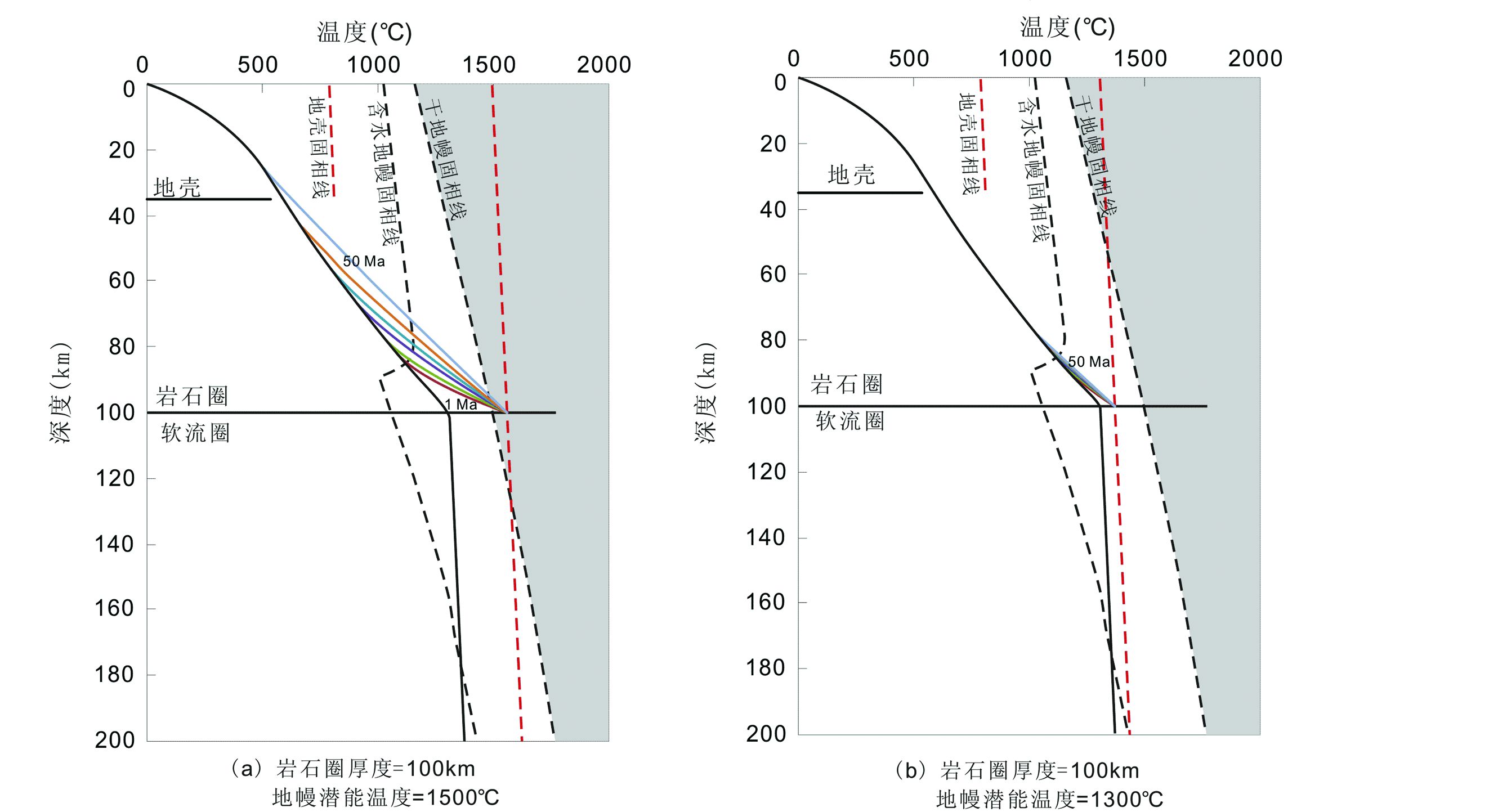
|
图 10 在地幔柱(a)和正常软流圈(b)作用下通过热传导导致的岩石圈地温梯度的变化 计算方法见Gibson et al. (2006) ,图中地幔和地壳岩石的固相线取自Xu et al. (2008) Fig. 10 Variation in geotherm of the lithosphere due to conductive-heating from the mantle plume (a) and from normal asthenosphere (b) The modeling approach follows Gibson et al. (2006) . Solidi of crustal and mantle rocks (granite, tonalite, basalt and sediment) are taken after Xu et al. (2008) |
如果华北晚中生代早期幔源岩浆来自富集岩石圈地幔,由于富集组分不能在短时间内重复供给(Xu, 2001; Xu et al., 2004a; 徐义刚等, 2009),因此这类岩浆作用不会持续很长时间(Gibson et al., 2006)。然而华北中生代富集地幔岩浆作用至少持续了30Ma(徐义刚等,2009;本文资料)。这要求富集地幔熔融时,岩石圈地幔也因热侵蚀作用(Xu, 2001)或水化作用(牛耀龄, 2005)或者两者的联合作用而发生减薄。在岩石圈减薄过程中对流软流圈对岩石圈地幔的热传递更为有效,而且软流圈本身也能作为源区物质参与岩浆作用。事实上,有越来越多的证据支持华北晚中生代岩浆作用中有来自软流圈地幔的贡献,例如:
(1) 本文报道的全岩资料显示,~100Ma 李家庄玄武安山岩的Nb/La为0.7,εNd(t) 为-7.8,远高于早期岩浆(图 11)。
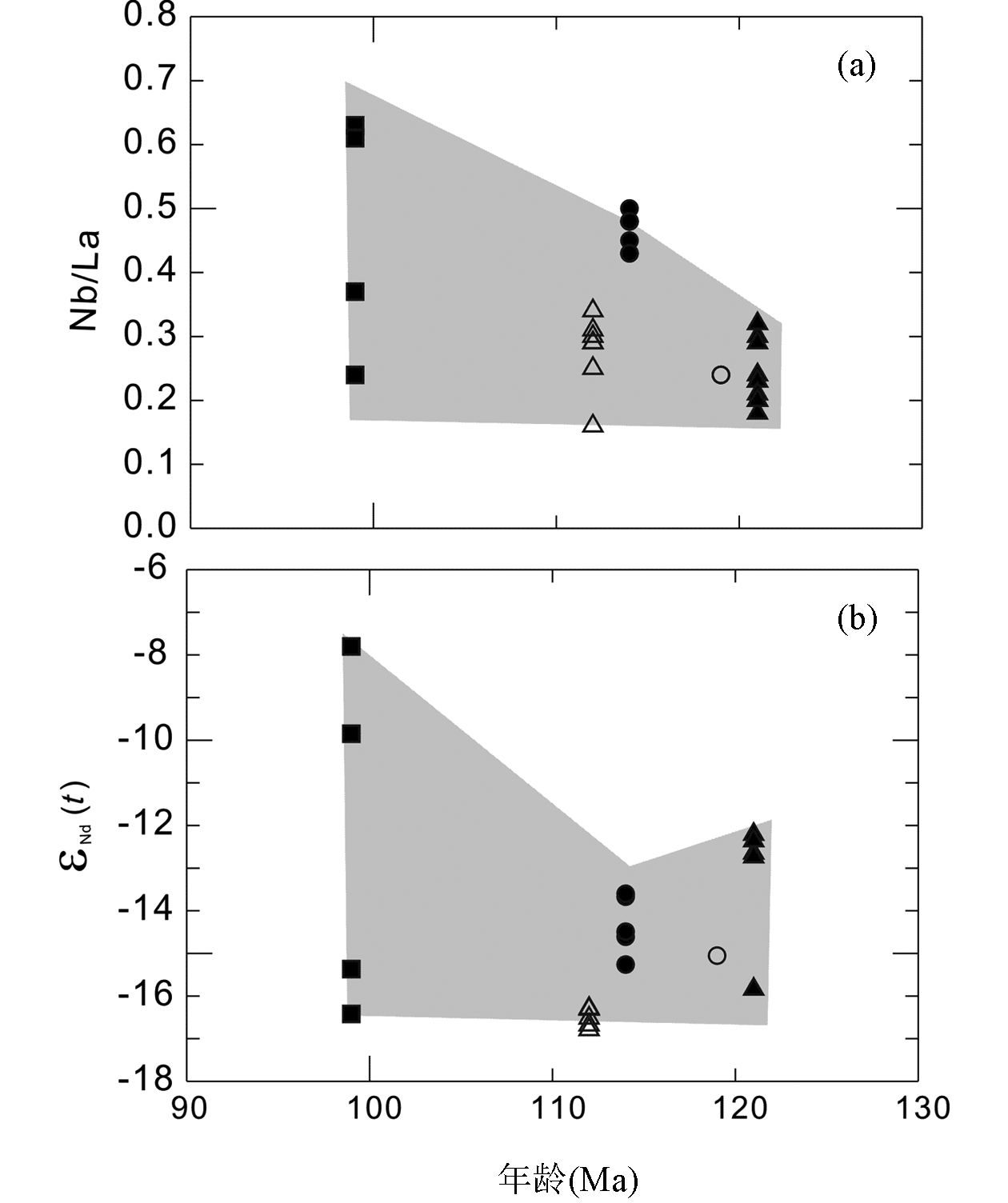
|
图 11 胶东青山群基性火山岩的Nb/La和εNd(t)随喷发时代的变化 Fig. 11 Temporal variation of Nb/La and εNd(t) of mafic rocks from Jiaodong Peninsula |
(2) 由于华北中生代富集地幔中含有大量再循环地壳组分,青山群火山岩的微量元素和同位素组成由地壳组分所控制,因此全岩地球化学组分很难示踪软流圈地幔的贡献,锆石的Hf同位素示踪则在这方面显示其优越性。徐义刚等(2007) 发现山东早白垩岩浆中新生锆石的εHf(t)随年龄的减小而逐渐增大,如年龄为125~132 Ma的锆石的εHf(t)变化于-10~-18,而120~125Ma的锆石的εHf(t) 变化于-1~-8。Yang et al.(2007a, b) 在辽东早白垩花岗岩中鉴别出εHf(t)正值的锆石,从而证明软流圈地幔不仅为华北东部早白垩世花岗岩的形成提供了物源,也提供了热源。
由于软流圈地幔熔融与岩石圈减薄紧密相关(McKenzie and Bickle, 1988),因此华北晚中生代岩浆作用中软流圈地幔组分的存在暗示华北岩石圈在早白垩甚至更早就已经开始减薄了(徐义刚等,2009)。
6 结论(1) Ar-Ar 定年表明,胶东地区青山群基性火山岩喷发年龄为122~113Ma,早于青山群酸性火山岩(110~98Ma);
(2) 元素和同位素示踪研究表明,胶东地区青山群基性火山岩为交代富集地幔部分熔融作用的产物,前人的工作则揭示青山群酸性火山岩为古老下地壳和中生代底侵岩浆的熔融产物。因此胶东青山群火山作用记录了岩浆熔融源区从上地幔向下地壳的转变。这与长时间尺度的岩石圈减薄过程中热能由地幔向地壳传递过程相吻合,而不同于地壳拆沉作用所预测的岩浆演化趋势。
| [] | Basu AR, Wang J, Huang W, Xie G and Tatsumoto M. 1991. Major element, REE, and Pb, Nd and Sr isotopic geochemistry of Cenozoic volcanic rocks of eastern China: Implications for their origin from suboceanic-type mantle reservoirs. Earth and Planetary Science Letters, 105: 149–169. DOI:10.1016/0012-821X(91)90127-4 |
| [] | Ben Othman D, White WM and Patchett J. 1989. The geochemistry of marine sediments, island arc magma genesis and crust-mantle recycling. Earth and Planetary Science Letters, 94: 1–21. DOI:10.1016/0012-821X(89)90079-4 |
| [] | Chen B and Zhai M. 2003. Geochemistry of Late Mesozoic lamprophyre dykes from the Taihang Mountains, North China,and implications for the sub-continental lithospheric mantle. Geological Magazine, 140: 87–93. DOI:10.1017/S0016756802007124 |
| [] | Dai JS and Lu KZ. 1995. Kinematics of the Jiaolai Basin. Journal of China University of Petrolum University, 19: 1–6. |
| [] | DePaolo DJ. 1981. Trace element and isotopic effects of combined wallrock assimilation and fractional crystallization. Earth and Planetary Science Letters, 53: 189–202. DOI:10.1016/0012-821X(81)90153-9 |
| [] | Fan WM and Menzies MA. 1992. Destruction of aged lower lithosphere and accretion of asthenosphere mantle beneath eastern China. Geotectonica et Metallogenia, 16: 171–180. |
| [] | Fan WM, Guo F, Wang YJ, Lin G and Zhang M. 2001. Post-orogenic bimodal volcanism along the Sulu orogenic belt in eastern China. Physics and Chemistry of the Earth. Part A: Solid Earth and Geodesy, 26: 733–746. DOI:10.1016/S1464-1895(01)00123-5 |
| [] | Fan WM, Guo F, Wang YJ and Zhang M. 2004. Late Mesozoic volcanism in the northern Huaiyang tectono-magmatic belt, central China: Partial melts from a lithospheric mantle with subducted continental crust relicts beneath the Dabie orogen?. Chemical Geology, 209: 27–48. DOI:10.1016/j.chemgeo.2004.04.020 |
| [] | Frost CD, Bell JM, Frost BR and Chamberlain KR. 2001. Crustal growth by magmatic underplating: Isotopic evidence from the northern Sherman batholith. Geology, 29: 515–518. DOI:10.1130/0091-7613(2001)029<0515:CGBMUI>2.0.CO;2 |
| [] | Gao S, Rudnick RL, Carlson RW, McDonough WF and Liu YS. 2002. Re-Os evidence for replacement of ancient mantle lithosphere beneath the North China Craton. Earth and Planetary Science Letters, 198: 307–322. DOI:10.1016/S0012-821X(02)00489-2 |
| [] | Gao S, Rudnick RL, Xu WL, Yuan HL, Liu YS, Walker R, Puchtel IS, Liu XM, Huang H, Wang XR and Yang J. 2008. Recycling deep cratonic lithosphere and generation of intraplate magmatism in the North China Craton. Earth and Planetary Science Letters, 270: 41–53. DOI:10.1016/j.epsl.2008.03.008 |
| [] | Gao S, Zhang JF, Xu WL and Liu YS. 2009. Delamination and destruction of the North China Craton. Chinese Science Bulletin, 54: 3367–3378. |
| [] | Gibson SA, Thompson RN and Day JA. 2006. Timescales and mechanisms of plume-lithosphere interactions: 40Ar/39Ar geochronology and geochemistry of alkaline igneous rocks from the Parana-Etendeka large igneous province. Earth and Planetary Science Letters, 251: 1–17. DOI:10.1016/j.epsl.2006.08.004 |
| [] | Griffin WL, Zhang AD, O’Reilly SY and Ryan CG. 1998. Phanerozoic evolution of the lithosphere beneath the Sino-Korean craton. In: Flower MFJ, Chung SL, Lo CH and Lee TY (eds.). Mantle Dynamics and Plate Interactions in East Asia Am. Geophy. Union, Washington, D. C., Geodyn. Ser., 27: 107-126 |
| [] | Guo F, Fan WM, Wang YJ and Lin G. 2001. Late Mesozoic mafic intrusive complexes in North China Block: Constraints on the nature of subcontinental lithospheric mantle. Physics and Chemistry of the Earth. Part A: Solid Earth and Geodesy, 26: 759–771. |
| [] | Guo F, Fan WM, Wang YJ and Lin G. 2003. Geochemistry of Late Mesozoic mafic magmatism in west Shandong Province, eastern China: Characterizing the lost lithospheric mantle beneath the North China Block. Geochemical Journal, 37: 63–77. DOI:10.2343/geochemj.37.63 |
| [] | Huang XL, Xu YG and Liu DY. 2004. Geochronology, petrology and geochemistry of the granulite xenoliths from Nushan, eastern China: Implication for a heterogeneous lower crust beneath the Sino-Korean Craton. Geochimica et Cosmochimica Acta, 68: 127–149. DOI:10.1016/S0016-7037(03)00416-2 |
| [] | Jahn BM, Wu FY, Lo CH and Tsai CH. 1999. Crus-tmantle interaction induced by deep subduction of the continental crust: Geochemical and Sr-Nd isotopic evidence from post-collisional mafic-ultramafic intrusions of the northern Dabie complex, Central China. Chemical Geology, 157: 119–146. DOI:10.1016/S0009-2541(98)00197-1 |
| [] | Li SG, Nie YH, Hart SR and Zheng SG. 1998. Upper mantle-deep subducted continental crust interaction: (II) Sr and Nd isotopic constraints on the syn-collisional mafic to ultramafic intrusions in the northern Dabieshan, eastern China. Science in China (Series D), 28: 18–22. |
| [] | Liang XR, Wei GJ and Li XH. 2003. Precise determination of 143Nd/144Nd and Sm/Nd ratios using (LP)MC-ICPMS. Geochimica, 32: 91–96. |
| [] | Ling WL, Xie XJ, Liu XM and Cheng JP. 2007. Zircon U-Pb dating on the Mesozoic volcanic suite from the Qingshan Group stratotype section in eastern Shandong Province and its tectonic significance. Science in China (Series D), 50: 813–824. DOI:10.1007/s11430-007-2065-6 |
| [] | Ling WL, Duan RC, Xie XJ, Zhang YQ, Zhang JB, Cheng JP, Liu XM and Yang HM. 2009. Contrasting geochemistry of the Cretaceous volcanic suites in Shandong Province and its implications for the Mesozoic lower crust delamination in the eastern North China craton. Lithos, 113: 640–658. DOI:10.1016/j.lithos.2009.07.001 |
| [] | Liu S, Hu RZ, Zhao JH and Feng CX. 2003. Tectonic setting and petrogensis of the Qiangshan volcanic rocks in western Shandong: Evidence from major and element geochemistry. Geochimica, 32: 306–316. |
| [] | Liu Y, Liu HC and Li XH. 1996. Precise determination of >40 trace elements in rock samples using ICP-MS. Geochimica, 25: 552–558. |
| [] | Liu YS, Gao S, Kelemen P, et al. 2008. Recycled lower continental crustal controls contrasting source compositions of Mesozoic and Cenozoic basalts in eastern China. Geochimica et Cosmochimica Acta, 72: 2349–2376. DOI:10.1016/j.gca.2008.02.018 |
| [] | McKenzie DP and Bickle MJ. 1988. The volume and composition of melt generated by extension of the lithosphere. Journal of Petrology, 29: 625–679. DOI:10.1093/petrology/29.3.625 |
| [] | McLennan SM, Taylor SR, McCulloch MT and Maynard JB. 1990. Geochemical and Nd-Sr isotopic composition of deep-sea turbidites. Geochim. Cosmochim. Acta, 54: 2015–2050. DOI:10.1016/0016-7037(90)90269-Q |
| [] | Menzies MA, Fan WM and Zhang M. 1993. Palaeozoic and Cenozoic lithoprobes and the loss of >120km of Archaean lithosphere, Sino-Korean craton, China. In: Prichard HM, Alabaster T, Harris NBW and Neary CR (eds.). Magmatic Processes and Plate Tectonics. Geological Society Special Publication, 76: 71-78 |
| [] | Menzies MA and Xu YG. 1998. Geodynamics of the North China Craton. In: Flower M, Chung SL, Lo CH and Lee TY (eds.). Mantle Dynamics and Plate Interactions in East Asia. AGU Geodynamic Series 27: 155-165 |
| [] | Niu YL. 2005. Generation and evolution of basaltic magmas: Some basic concepts and a new view on the origin of Mesozoic-Cenozoic basaltic volcanism in eastern China. Geological Journal of China Universities, 11: 9–46. |
| [] | Peng ZC, Zartman RE, Futa E and Chen DG. 1986. Pb-,Sr- and Nd-isotopic systematics and chemical characteristics of Cenozoic basalts, eastern China. Chemical Geology, 59: 3–33. DOI:10.1016/0168-9622(86)90054-0 |
| [] | Qiu HN and Jiang YD. 2007. Sphalerite 40Ar/39Ar progressive crushing and stepwise heating techniques. Earth and Planetary Science Letters, 256: 224–232. DOI:10.1016/j.epsl.2007.01.028 |
| [] | Qiu JS, Wang DZ, Luo QH and Liu H. 2001a. 40Ar-39Ar dating for volcanic rocks of Qingshan Formation in Jiaolai basin, eastern Shandong Province: A case study of the Fenlingshan volcanic apparatus in Wulian County. Geological Journal of China Universities, 7: 351–355. |
| [] | Qiu JS, Xu XS and Luo QH. 2001b. 40Ar-39Ar dating and source denoting of K-rich volcanic rocks and lamprophyres in western Shandong Province. Chinese Science Bulletin, 46: 1500–1508. |
| [] | Qiu JS, Jiang SY, Zhang XL and Hu J. 2004. Petrogenesis of late Mesozoic K-rich volcanic rocks from northern and southern sides of the Dabie-Sulu orogenic belt: Trace element and Sr-Nd-Pb isotope constraints. Journal of Earth Science, 25: 255–262. |
| [] | Song Y, Frey FA and Zhi X. 1990. Isotopic characteristics of Hannuoba basalts, eastern China: Implications for their petrogenesis and the composition of subcontinental mantle. Chemical Geology, 88: 35–52. DOI:10.1016/0009-2541(90)90102-D |
| [] | Sun SS and McDonough WF. 1989. Chemical and isotopic systematics of oceanic basalts: Implications for mantle composition and processes. In: Saunders AD and Norry MJ (eds.). Magmatism in the Ocean Basins. London, Geological Society Special Publication, 42: 313–345. DOI:10.1144/GSL.SP.1989.042.01.19 |
| [] | Tang YJ, Zhang HF and Ying JF. 2006. Asthenosphere-lithospheric mantle interaction in an extensional regime: Implication from the geochemistry of Cenozoic basalts from Taihang Mountains, North China Craton. Chemical Geology, 233: 309–327. DOI:10.1016/j.chemgeo.2006.03.013 |
| [] | Taylor HP and McLennan SM. 1985. The Continental Crust: Its Composition and Evolution. Oxford: Blackwell. |
| [] | Wei GJ, Liang XR and Li XH. 2002. Precise determination of Sr isotope composition of liquid and solid samples using (LP)MC-ICPMS. Geochimica, 31: 295–299. |
| [] | Winchester JA and Floyd PA. 1976. Geochemical magma type discrimination: Application to altered and metamorphosed basic igneous rocks. Earth and Planetary Science Letters, 28: 459–469. DOI:10.1016/0012-821X(76)90207-7 |
| [] | Wu FY, Xu YG, Gao S and Zheng JP. 2008. Controversial on studies of the lithospheric thinning and destruction of the North China Craton. Acta Petrologica Sinica, 24: 1145–1174. |
| [] | Xu GZ, Zhou R, Wang YF, She HQ, Li B, Du BM and Song MC. 2002. The intrinsic factors causing the significant differences in Mesozoic mineralization between Jiaodong and Luxi areas. Geoscience, 16: 9–18. |
| [] | Xu WL, Gao S, Wang QH, et al. 2006. Mesozoic crustal thickening of the eastern North China craton: Evidence from eclogite xenoliths and petrologic implications. Geology, 34: 721–724. DOI:10.1130/G22551.1 |
| [] | Xu YG. 2001. Thermo-tectonic destruction of the archaean lithospheric keel beneath the sino-korean craton in China: Evidence, timing and mechanism. Physics and Chemistry of the Earth, Part A: Solid Earth and Geodesy, 26: 747–757. DOI:10.1016/S1464-1895(01)00124-7 |
| [] | Xu YG, Huang XL, Ma JL, Wang YB, Iizuka Y, Xu JF, Wang Q and Wu XY. 2004a. Crust-mantle interaction during the tectono-thermal reactivation of the North China Craton: Constraints from SHRIMP zircon U-Pb chronology and geochemistry of Mesozoic plutons from western Shandong. Contributions to Mineralogy and Petrology, 147: 750–767. DOI:10.1007/s00410-004-0594-y |
| [] | Xu YG, Ma JL, Huang XL, Iizuka Y, Chung SL, Wang YB and Wu XY. 2004b. Early Cretaceous gabbroic complex from Yinan, Shandong Province: Petrogenesis and mantle domains beneath the North China Craton. International Journal of Earth Sciences, 93: 1025–1041. DOI:10.1007/s00531-004-0430-7 |
| [] | Xu YG, Ma JL, Feigenson MD, Frey FA and Liu JF. 2005. The role of lithosphere-asthenosphere interaction in the genesis of Quaternary tholeiitic and alkali basalts from Datong, western North China Craton. Chemical Geology, 224: 247–271. DOI:10.1016/j.chemgeo.2005.08.004 |
| [] | Xu YG, Wu XY, Luo ZY, Ma JL, Huang XL and Xie LW. 2007. Zircon Hf isotope compositions of Jurassic-Early Cretaceous intrusions in Shandong Province and its implications. Acta Petrolica Sinica, 23: 307–316. |
| [] | Xu YG, Luo ZY, Huang XL, He B, Xiao L, Xie LW and Shi YR. 2008. Zircon U-Pb and Hf isotope constraints on crustal melting associated with the Emeishan mantle plume. Geochimica et Cosmochimica Acta, 72: 3084–3104. DOI:10.1016/j.gca.2008.04.019 |
| [] | Xu YG, Li HY, Pang CJ and He B. 2009. On the timing and duration of the destruction of the North China Craton. Chinese Science Bulletin, 54: 1974–1989. |
| [] | Xu YG, Zhang HH, Qiu HN, Ge WC and Wu FY. 2012. Oceanic crust components in continental basalts from Shuangliao, Northeast China: Derived from the mantle transition zone?. Chemical Geology. DOI:10.1016/j.chemgeo.2012.01.027 |
| [] | Yan J and Chen JF. 2007. Geochemistry of Qingshan Formation volcanic rocks from Jiaolai Basin, eastern Shandong Province: Petrogenesis and geological implication. Geochimica, 36: 1–10. |
| [] | Yang JH, Wu FY and Wilde SA. 2003. A review of the geodynamic setting of large-scale Late Mesozoic gold mineralization in the North China Craton: An association with lithospheric thinning. Ore Geology Review, 23: 125–152. DOI:10.1016/S0169-1368(03)00033-7 |
| [] | Yang JH, Wu FY, Wilde SA, Xie LW, Yang YH and Liu XM. 2007a. Tracing magma mixing in granite genesis: In situ U-Pb dating and Hf-isotope analysis of zircons. Contribution to Mineralogy and Petrology, 153: 177–190. |
| [] | Yang JH, Sun JF, Chen FK, Wilde SA and Wu FY. 2007b. Sources and petrogenesis of Late Triassic dolerite dikes in the Liaodong Peninsula: Implications for post-collisional lithosphere thinning of eastern North China Craton. Journal of Petrology, 48: 1973–1997. DOI:10.1093/petrology/egm046 |
| [] | Yang W and Li SG. 2008. Geochronology and geochemistry of the Mesozoic volcanic rocks in western Liaoning: Implications for lithospheric thinning of the North China Craton. Lithos, 102: 88–117. DOI:10.1016/j.lithos.2007.09.018 |
| [] | Zhang HF, Sun M, Zhou XH, Fan WM, Zhai MG and Yin JF. 2002. Mesozoic lithospheric destruction beneath the North China Carton: Evidence from major-, trace-element and Sr-Nd-Pb isotope studies of Fangcheng basalts. Contribution to Mineralogy and Petrology, 144: 241–253. DOI:10.1007/s00410-002-0395-0 |
| [] | Zhang HF, Sun M, Zhou XH, et al. 2003a. Secular evolution of the lithosphere beneath the eastern North China Craton: Evidence from Mesozoic basalts and high-Mg andesites. Geochimica et Cosmochimica Acta, 67: 4373–4387. DOI:10.1016/S0016-7037(03)00377-6 |
| [] | Zhang Y, Dong S and Shi W. 2003b. Cretaceous deformation history of the middle Tan-Lu fault zone in Shandong Province, eastern China. Tectonophysics, 363: 243–258. DOI:10.1016/S0040-1951(03)00039-8 |
| [] | Zheng JP. 1999. Mesozoic-Cenozoic Mantle Replacement and Lithospheric Thinning beneath East China. Wuhan: China University of Geosciences Press: 1–126. |
| [] | Zheng JP and Lu FX. 1999. Petrologic characteristics of kimberliteborne mantle xenoliths from the Shandong and Liaoning Peninsula: Paleozoic lithosphere mantle and its heterogeneity. Acta Petrologica Sinica, 15: 65–74. |
| [] | Zhou X, Sun M, Zhang G and Chen S. 2002. Continental crust and lithospheric mantle interaction beneath North China: Isotopic evidence from granulite xenoliths in Hannuoba, Sino-Korean craton. Lithos, 62: 111–124. DOI:10.1016/S0024-4937(02)00110-X |
| [] | Zhu G, Jiang DZ, Zhang BL and Chen Y. 2012. Destruction of the eastern North China Craton in a back-arc setting: Evidence from crustal deformation kinematics. Gondwana Research. DOI:10.1016/j.gr.2011.08.005 |
| [] | Zhu RX, Chen L, Wu FY and Liu JL. 2011. Timing, extent and mechanism of destruction of the North China Craton. Scientia Sinica (Terrae), 41: 583–592. |
| [] | 戴俊生, 陆克政. 1995. 胶莱盆地的运动学特征. 石油大学学报(自然科学版), 19: 1–6. |
| [] | 高山, 章军峰, 许文良, 刘勇胜. 2009. 拆沉作用与华北克拉通破坏. 科学通报, 54: 3367–3378. |
| [] | 李曙光, 聂永红, HartSR, 张宗清. 1998. 俯冲陆壳与上地幔的相互作用——II大别山同碰撞镁铁-超镁铁岩的Sr、Nd同位素地球化学. 中国科学(D辑), 26: 18–22. |
| [] | 梁细荣, 韦刚健, 李献华. 2003. 利用MC-ICPMS精确测定143Nd/144Nd和Sm/Nd比值. 地球化学, 32: 91–96. |
| [] | 凌文黎, 谢先军, 柳小明, 程建萍. 2006. 鲁东中生代标准剖面青山群火山岩锆石U-Pb年龄及其构造意义. 中国科学 (D辑), 36: 401–411. |
| [] | 刘燊, 胡瑞忠, 赵军红, 冯彩霞. 2003. 鲁西青山组火山岩形成的构造背景及其成因探讨: 主元素和微量元素证据. 地球化学, 32: 306–316. |
| [] | 刘颖, 刘海臣, 李献华. 1996. 用ICP-MS准确测定岩石样品中的40余种微量元素. 地球化学, 25: 552–558. |
| [] | 牛耀龄. 2005. 玄武岩浆起源和演化的一些基本概念以及对中国东部中-新生代基性火山岩成因的新思路. 高校地质学报, 11: 9–46. |
| [] | 邱检生, 王德滋, 罗清华, 刘洪. 2001a. 鲁东胶莱盆地青山组火山岩的Ar-Ar定年——以五莲分岭山火山机构为例. 高校地质学报, 7: 351–355. |
| [] | 邱检生, 徐夕生, 罗清华. 2001b. 鲁西富钾火山岩和煌斑岩的Ar-Ar定年及源区示踪. 科学通报, 46: 1500–1508. |
| [] | 邱检生, 蒋少涌, 张晓琳, 胡建. 2004. 大别-苏鲁造山带南北两侧晚中生代富钾火山岩的成因: 微量元素及Sr-Nd-Pb同位素制约. 地球学报, 25: 255–262. |
| [] | 韦刚健, 梁细荣, 李献华. 2002. (LP)MC-ICPMS方法精确测定液体和固体样品的Sr同位素组成. 地球化学, 31: 295–299. |
| [] | 吴福元, 徐义刚, 高山, 郑建平. 2008. 华北岩石圈减薄与克拉通破坏研究的主要学术争论. 岩石学报, 24: 1145–1174. |
| [] | 徐贵忠, 周瑞, 王艺芬, 佘宏全, 李兵, 杜本明, 宋明春. 2002. 胶东和鲁西地区中生代成矿作用重大差异性的内在因素. 现代地质, 16: 9–18. |
| [] | 徐义刚, 巫祥阳, 罗震宇, 马金龙, 黄小龙. 2007. 山东中侏罗纪-早白垩纪侵入岩的锆石Hf同位素组成及其意义. 岩石学报, 23: 307–316. |
| [] | 徐义刚, 李洪颜, 庞崇进, 何斌. 2009. 论华北岩石圈减薄的时限. 科学通报, 54: 1974–1989. |
| [] | 闫峻, 陈江峰. 2007. 鲁东青山组中性火山岩的地球化学特征: 岩石成因和地质意义. 地球化学, 36: 1–10. |
| [] | 郑建平. 1999. 中国东部地幔置换作用与中新生代岩石圈减薄. 武汉: 中国地质大学出版社: 1-126. |
| [] | 郑建平. 1999. 中国东部地幔置换作用与中新生代岩石圈减薄. 武汉: 中国地质大学出版社: 1-126. |
| [] | 朱日祥, 陈凌, 吴福元, 刘俊来. 2011. 华北克拉通破坏的时间、范围与机制. 中国科学(地球科学), 41: 583–592. |
 2012, Vol. 28
2012, Vol. 28



